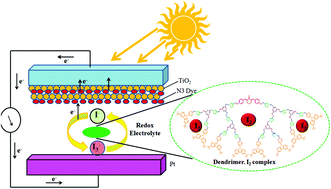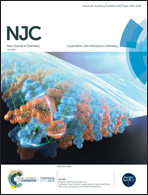Cyclohexadienone core 3,6-di-tert-butylcarbazole decorated triazole bridged dendrimers: synthesis, photophysical and electrochemical properties and application as an additive in dye-sensitized solar cells†
Abstract
Cyclohexadienone core 3,6-di-tert-butylcarbazole decorated triazole bridged dendrimers are synthesised up to the second generation using click chemistry via a convergent approach. The molar extinction coefficient and the intensity of the emission band increase with an increase in the dendrimer generation. The HOMO–LUMO energy level and the energy gap Eg obtained from photophysical and electrochemical parameters coincide with the results obtained from DFT calculations. The higher generation dendrimer 3 (G2) shows a higher Voc value and an increased efficiency of 9.01% when used as additive in DSSCs compared to the lower generation dendrimers 2 (G1) and 1 (G0) under 100 mW cm−2 illumination. Further, Nyquist plots obtained from electrochemical impedance measurements also show that the higher generation dendrimer G2 provides an increased number of charge transport pathways, which enhances interfacial electron transport and reduces the recombination dynamics.



 Please wait while we load your content...
Please wait while we load your content...